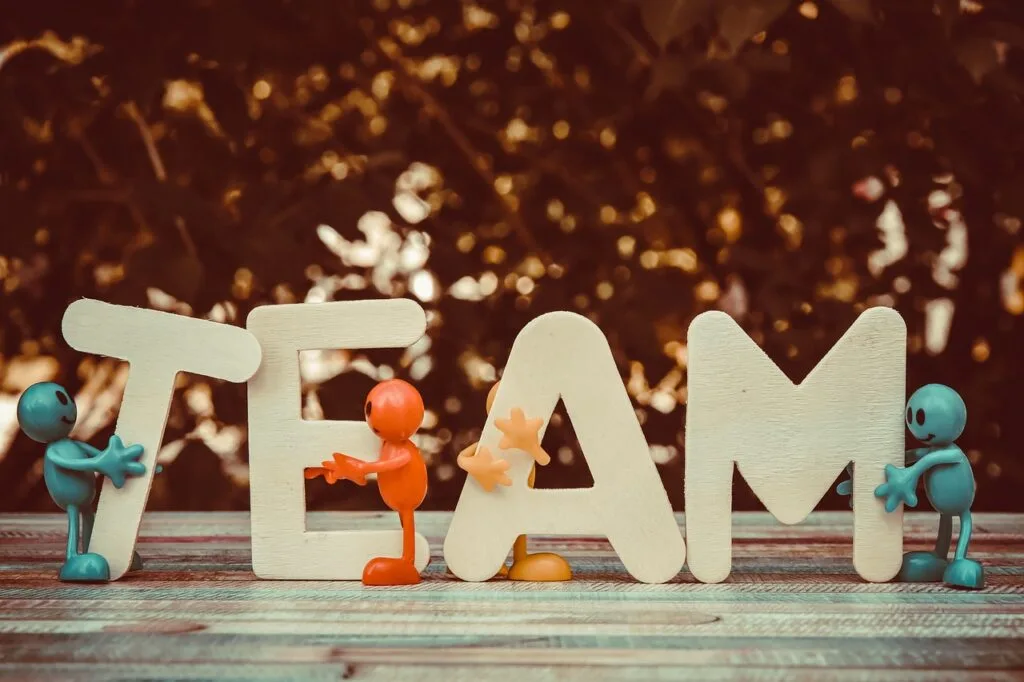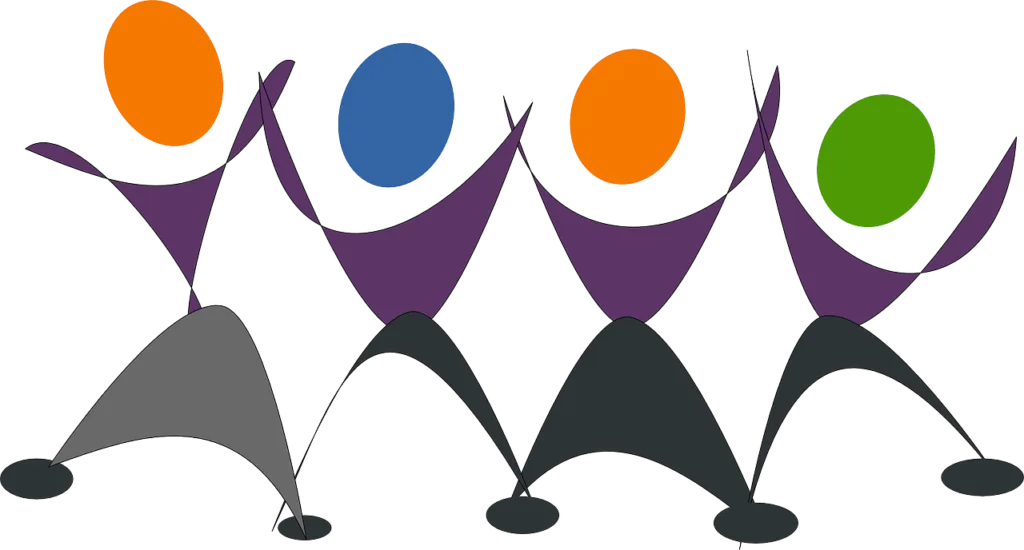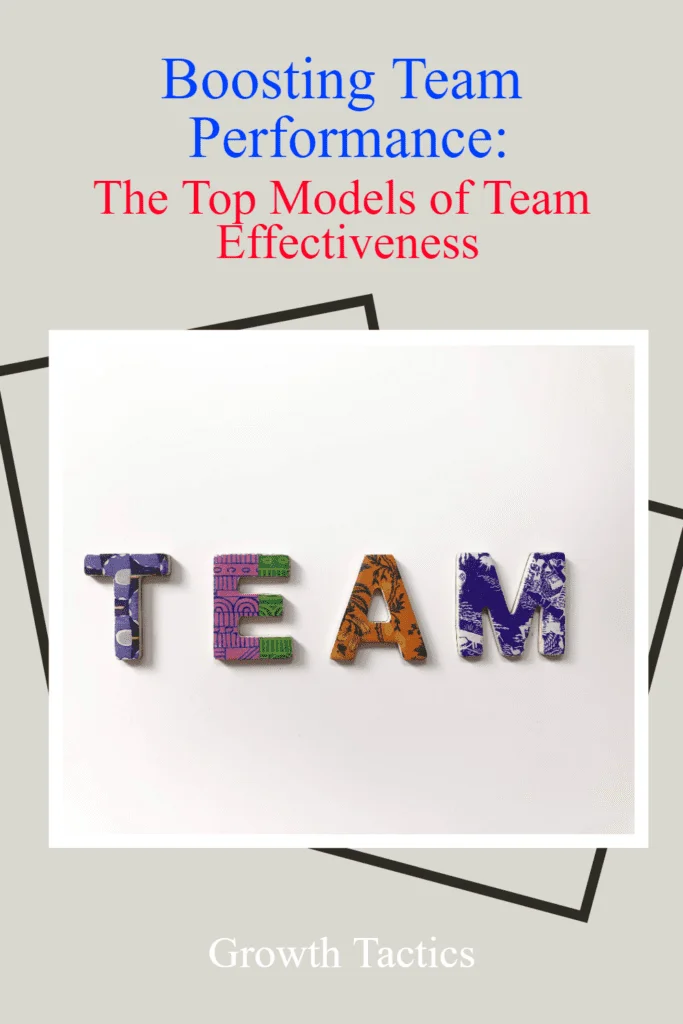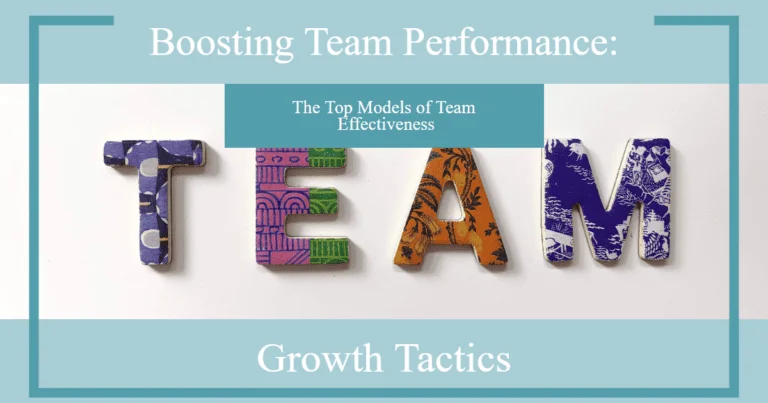Jump To Section
What is a team effectiveness model?
A team effectiveness model is a framework that helps teams to understand and improve their performance. These models provide a structure for teams to evaluate their strengths and weaknesses, identify areas for improvement, and develop strategies for achieving their goals. There are several models of team performance, each with its own unique approach to understanding and improving team effectiveness.
How Can Understanding Team Effectiveness Models Benefit You?

Understanding team effectiveness models can be really helpful for you and your team. By learning about the different models, you can identify areas where your team may need improvement and take steps to enhance their performance.
Using these models, you can build stronger teams by promoting trust, managing conflicts, fostering commitment, and holding team members accountable. This will help your team achieve better results by focusing on clear goals, effective processes, and strong interpersonal relationships.
You can also use these models to address common team challenges, like communication breakdowns, conflicts, and lack of accountability. Understanding team effectiveness models can provide you with tools and strategies to lead your team more effectively and enhance your leadership skills.
Characteristics of Team Effectiveness
In my years of working with teams, I’ve noticed some key traits that make them truly effective. Let’s dive into these characteristics that can help your team shine.
1. Clear Goals and Purpose
Effective teams know exactly what they’re working towards. When everyone understands the mission, it’s like magic. I’ve seen teams transform once they got clear on their purpose. It guides their decisions and keeps them focused on what really matters.
2. Strong Communication
Open and honest talk is the heartbeat of great teams. I remember a team that struggled until they started sharing ideas freely. Create an environment where everyone feels comfortable speaking up. This includes both formal meetings and casual chats.
3. Trust and Psychological Safety
Team members need to feel safe to take risks and be vulnerable. I once worked with a team where people were afraid to admit mistakes. Once we built trust, their performance skyrocketed. Encourage openness and support each other.
4. Diversity and Complementary Skills
The best teams I’ve seen have a mix of different perspectives and skills. It’s like a puzzle where each piece brings something unique. Embrace your differences and learn from each other. Together, you’ll achieve more than you could alone.
5. Adaptability
In today’s fast-paced world, teams need to roll with the punches. I’ve watched flexible teams thrive while rigid ones struggle. Be ready to change course when needed. It’s okay to adjust your plans as you go.
6. Accountability
Take ownership of your work and support your teammates. I once led a team where we started holding each other accountable. It was tough at first, but it made us stronger. Remember, you’re all in this together.
7. Collaborative Problem-Solving
Work together to overcome obstacles. Don’t try to solve everything alone. I’ve seen the power of collective thinking in action. It’s amazing what a team can come up with when they put their heads together.
8. Continuous Learning and Improvement
Always look for ways to get better. The best teams I know regularly reflect on their work. They’re not afraid to admit what isn’t working and try new approaches. Keep learning and growing together.
These characteristics have helped many teams I’ve worked with become more effective. Try focusing on one or two at a time and see how it impacts your team. Remember, every team is unique, so find what works best for you. With effort and patience, you can build a team that truly shines.
Team Effectiveness Models

Here are some of the most popular models of team performance:
The Hackman Model
The Hackman model is particularly useful in situations where team members may be working remotely or across different locations. In such situations, it can be challenging to establish a sense of team identity and foster collaboration. However, by creating a supportive team environment, team leaders can help team members feel more connected and engaged.
The model suggests that team leaders should focus on providing resources and support to help team members achieve their goals. This includes ensuring that team members have the necessary skills and experience to perform their tasks effectively. Additionally, creating a positive team environment that fosters collaboration and open communication is essential for team success.
One of the key features of the Hackman model is the importance of a supportive organizational context. This includes factors such as organizational culture, leadership support, and access to resources. By creating a supportive organizational context, team leaders can help team members feel more empowered and motivated to achieve their goals.
Another important aspect of the Hackman model is the need for clear goals. When team members understand what they are working towards and why it is important, they are more likely to be motivated and focused. Team leaders should work with team members to establish clear goals that are aligned with the organization’s overall mission and vision.
Overall, the Hackman model provides a useful framework for understanding how to create a supportive team environment that fosters collaboration and success. By focusing on clear goals, a supportive organizational context, and the right mix of skills and experience, team leaders can help their teams achieve their full potential.
The T7 Model
I’ve seen a lot of teams struggle in fast-changing environments. That’s where the T7 Model comes in handy. It’s like a compass for teams, helping them navigate tricky situations. Let me break it down for you in a way that’s easy to understand and apply.
Task: Know Your Purpose
First up is task. This is all about knowing what you’re trying to achieve. I once worked with a team that was all over the place until we sat down and really nailed down their goals. Once everyone was on the same page, it was like night and day. They started making better decisions and using their resources wisely.
Team: Build Your Identity
Next, we have team. This is about feeling like you’re part of something special. I’ve seen teams transform when they develop a strong sense of who they are together. They start supporting each other and working together like a well-oiled machine.
Individuals: Embrace Your Uniqueness
The individuals factor is all about you and your teammates. Everyone brings something different to the table. In my experience, the best teams are like a puzzle – each piece is unique, but they all fit together perfectly.
Boundaries: Know Your Place
Boundaries might sound limiting, but they’re actually super helpful. It’s about understanding how your team fits into the bigger picture. I’ve helped teams clarify their boundaries, and it’s amazing how much smoother things run when everyone knows their role.
Context: Understand Your Environment
Context is all about the world your team operates in. Is your organization supportive? Do you have the resources you need? I’ve seen teams thrive when they have a good grasp of their context and know how to work within it.
Learning: Grow Together
Learning is crucial. The best teams I’ve worked with are always trying to get better. They’re not afraid to admit mistakes and learn from them. It’s like they’re on a constant journey of improvement.
Leadership: Guide with Purpose
Finally, we have leadership. Good leaders can make or break a team. I’ve seen struggling teams turn around with the right leadership. It’s not just about giving orders – it’s about inspiring and guiding your team towards your shared goals.
Remember, every team is unique. Use these factors as a guide, but don’t be afraid to adapt them to fit your specific needs. I’ve found that focusing on these areas can really help teams up their game, especially when things get tough. Give it a try and see how it works for you!
Tuckman’s FSNP Model

The first stage of the Tuckman model is forming, where team members are introduced and begin to get to know each other. During this stage, team members are often polite and avoid conflict. However, they are also trying to establish their roles and responsibilities within the team.
The second stage is storming, where team members may begin to experience conflict and tension. This stage is characterized by disagreements and power struggles as team members try to establish their positions within the team. It is important for team leaders to provide support and guidance during this stage to help team members work through their differences.
The third stage is norming, where team members begin to establish a sense of cohesion and cooperation. During this stage, team members develop a shared understanding of their goals and objectives, and begin to work together more effectively.
The final stage is performing, where the team is able to work together effectively to achieve their goals. During this stage, team members have a clear understanding of their roles and responsibilities, and are able to work together collaboratively to achieve their objectives.
It is important to note that the Tuckman model is not a linear process, and teams may move back and forth between stages depending on the situation. For example, a team may experience a setback that causes them to move back into the storming stage.
Overall, the Tuckman model provides a useful framework for understanding the natural development process that teams go through. By understanding these stages, team leaders can better support their teams and help them navigate the challenges that arise during the team development process.
The Katzenbach and Smith Model
The Katzenbach and Smith model identifies two key types of teams: working teams and leadership teams. Working teams are focused on achieving specific tasks and goals, while leadership teams are focused on making strategic decisions and setting direction for the organization.
The model emphasizes the importance of team identity, which is created through a shared purpose and a sense of belonging. Teams that have a strong sense of identity are better able to collaborate effectively and make decisions that support their overall mission.
The model also highlights the importance of team performance, which is achieved through a combination of individual skills and team dynamics. Teams that have the right mix of skills and experience are better able to perform their tasks effectively, while teams that have a strong sense of identity and purpose are more likely to work together collaboratively and achieve their goals.
The Katzenbach and Smith model also emphasizes the importance of team leadership, which is critical in establishing a shared purpose and creating a supportive team environment. Effective team leaders are able to motivate and guide team members towards achieving their goals, while also creating a culture of trust and collaboration.
Overall, the Katzenbach and Smith model provides a useful framework for understanding the importance of team identity and shared purpose in team performance. By focusing on these key factors, teams can improve their performance and achieve their goals more effectively.
The Drexler/Sibbet Team Performance
I’ve seen countless teams struggle to reach their full potential. That’s why I love the Drexler/Sibbet model. It’s like a GPS for team development, guiding you through seven crucial stages. Let’s break them down in a way that’s easy to understand and apply to your own team.
Orientation: Getting to Know You
First up is orientation. This is where you start to gel as a team. I remember when I first joined a new project team. We spent time learning about each other’s strengths and setting some ground rules. It made a huge difference in how smoothly we worked together later on.
Trust Building: Creating a Safe Space
Next comes trust building. This is where you start to feel comfortable with your teammates. In my experience, teams that trust each other aren’t afraid to share wild ideas or admit mistakes. It’s like creating a safety net for creativity and growth.
Goal Clarification: Mapping Your Journey
Now it’s time to get clear on your goals. I once worked with a team that was all over the place until we sat down and really nailed down what we wanted to achieve. Suddenly, everyone had a sense of direction and purpose.
Commitment: All Hands on Deck
Commitment is where things start to get real. This is about everyone buying into the team’s mission. I’ve seen teams create powerful mission statements that really fired everyone up. It’s like lighting a spark that turns into a roaring flame.
Implementation: Making It Happen
Implementation is where the rubber meets the road. This is when you start ticking off those milestones. I love this stage because you can feel the energy as the team starts to make real progress.
High Performance: Hitting Your Stride
High performance is when your team really starts to shine. I’ve been part of teams that reached this stage, and let me tell you, it’s an amazing feeling. You’re not just meeting goals, you’re smashing them and constantly finding ways to do even better.
Renewal: Celebrate and Recharge
Finally, there’s renewal. This is where you take a moment to pat yourselves on the back and recharge your batteries. I always encourage teams to celebrate their wins, big and small. It keeps the motivation high and sets you up for the next challenge.
Remember, every team is unique, and you might move through these stages at different speeds. That’s okay! The important thing is to keep moving forward, learning, and growing together. I’ve seen this model work wonders for all kinds of teams. Give it a try and see how it can transform your team’s performance!
The GRPI Model of Team Effectiveness
The GRPI model identifies four key elements that are critical to team effectiveness: goals, roles, processes, and interpersonal relationships.
The first element, goals, refers to the team’s objectives and what they are trying to achieve. Teams that have clear and specific goals are better able to focus their efforts and work together towards a common objective.
The second element, roles, refers to the specific responsibilities and tasks assigned to each team member. Teams that have well-defined roles are better able to work together effectively and avoid conflicts or misunderstandings.
The third element, processes, refers to the procedures and methods that the team uses to achieve its goals. Teams that have effective processes in place are better able to work efficiently and effectively towards their objectives.
The fourth element, interpersonal relationships, refers to the dynamics and communication between team members. Teams that have strong interpersonal relationships are better able to collaborate effectively and work through challenges and conflicts.
The GRPI model emphasizes the importance of addressing each of these four elements to achieve team effectiveness. By setting clear goals, defining roles and responsibilities, establishing effective processes, and building strong interpersonal relationships, teams can improve their performance and achieve their objectives more effectively.
Overall, the GRPI model provides a useful framework for understanding the key elements that contribute to team effectiveness. By focusing on these elements and working to improve them, teams can optimize their performance and achieve their goals more effectively.
The Lencioni Model
The Lencioni model identifies five key elements that are critical to team effectiveness: trust, conflict, commitment, accountability, and results.
The first element, trust, refers to the level of trust and confidence that team members have in each other. Teams that have high levels of trust are better able to communicate effectively, collaborate, and work towards common goals.
The second element, conflict, refers to the ability of team members to manage and resolve conflicts effectively. Teams that can manage conflict in a constructive manner are better able to make decisions, solve problems, and work together effectively.
The third element, commitment, refers to the level of commitment that team members have towards achieving the team’s goals. Teams that are committed to their goals are more likely to work hard and persevere through challenges and setbacks.
The fourth element, accountability, refers to the ability of team members to hold themselves and each other accountable for their actions and performance. Teams that hold each other accountable are better able to maintain high standards of performance and achieve their goals.
The fifth element, results, refers to the ability of the team to achieve its goals and deliver results. Teams that are focused on achieving results are more likely to work together effectively and make decisions that support their overall mission.
The Lencioni model emphasizes the importance of addressing each of these five elements to achieve team effectiveness. By building trust, managing conflict effectively, fostering commitment, holding each other accountable, and focusing on results, teams can improve their performance and achieve their objectives more effectively.
Overall, the Lencioni model provides a useful framework for understanding the key elements that contribute to team effectiveness. By focusing on these elements and working to improve them, teams can optimize their performance and achieve their goals more effectively.
Choosing the right team effectiveness model for your team
When it comes to choosing the right team effectiveness model for your team, there are several factors to consider. Here are some steps you can take to help you make the best decision:
- Identify your team’s strengths and weaknesses: Take a close look at your team’s current performance and identify areas where you are excelling and areas where you are struggling. This will help you determine which model will be most helpful in addressing your team’s specific needs.
- Consider your team’s goals: What are your team’s objectives and what do you hope to achieve? The model you choose should align with your team’s goals and help you make progress toward achieving them.
- Evaluate the challenges you are facing: What are the biggest challenges your team is currently facing? Do you need to improve communication, collaboration, decision-making, or something else? The model you choose should address the specific challenges you are facing.
- Research different models: Take some time to research different team effectiveness models, such as the ones we’ve discussed above. Consider the pros and cons of each model and how they might apply to your team’s specific situation.
- Consult with your team: It’s important to involve your team in the decision-making process. Discuss the different models with your team and get their input on which one they think would be most helpful.
By taking these steps, you can choose the right team effectiveness model for your team and help them improve their performance and achieve their goals. Remember, no model is perfect, and you may need to adapt and customize it to fit your team’s unique needs and circumstances.
Did you find this article on team effectiveness models useful? Don’t forget to share and subscribe for more Growth Tactics.


